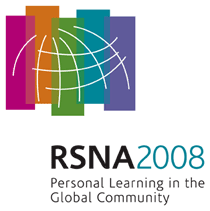
Abstract Archives of the RSNA, 2008
SSE02-04
Quantifying Diagnostic Confidence in Free-Text Mammography Reporting
Scientific Papers
Presented on December 1, 2008
Presented as part of SSE02: Breast Imaging (Mammography)
Bruce Ian Reiner MD, Abstract Co-Author: Nothing to Disclose
Eliot Lawrence Siegel MD, Abstract Co-Author: Research grant, General Electric Company
Research grant, Siemens AG
Speakers Bureau, TeraRecon, Inc
Advisory Board, Mercury Computer Systems, Inc
Board of Directors, Carestream Health, Inc
Research grant, XYBIX Systems, Inc
Research grant, Steelcase, Inc
Research grant, Anthro Corp
Research grant, RedRick Technologies Inc
Research grant, Evolved Technologies Corporation
Research grant, Barco nv
Research grant, Intel Corporation
Research grant, Herman Miller, Inc
Research grant, Anatomical Travelogue, Inc
Rakhi Goel MD, Presenter: Nothing to Disclose
Tara Ann Morgan MD, Abstract Co-Author: Nothing to Disclose
Joseph Jen-Sho Chen MD, Abstract Co-Author: Nothing to Disclose
Despite the utilization of the breast imaging reporting and data system (BIRADS) the use of terms of uncertainty and disclaimers persists. The purpose of the study was to analyze text related to radiologists’ diagnostic confidence with the use of free-text mammography reporting, determine the rate of use of terms of uncertainty and correlate the use of terms suggesting uncertainty with BIRADS codes and the type of study performed.
Data mining of a multi-institutional mammography database was performed using natural language processing (NLP) software, which was externally validated through a manual report audit. Using the NLP software, “uncertainty terms” (e.g. cannot exclude), were extracted from the mammography reports and correlated with the type of mammogram and corresponding BIRADS codes
Of the 141,787 mammography reports analyzed, 11% represented diagnostic mammograms and 89% screening mammograms. The frequency distribution of “uncertainty terms” was found to be significant (p < 0.001) when correlating exam type and BIRADS code. Uncertainty terms were demonstrated in 19% of all diagnostic mammography reports, compared with only 2.8% of screening mammography reports. When correlating with the corresponding BIRADS codes, 4.3% of negative mammography reports (BIRADS 1 and 2) contained uncertainty terms, compared with 11.0% of equivocal mammography reports (BIRADS 0 and 3), and 10.5% of positive mammography reports (BIRADS 4 and 5).
A substantial percentage of existing mammography reports contain “uncertainty terms” that reflect equivocation and lack of diagnostic confidence on the part of the interpreting radiologist particularly for diagnostic mammograms where these terms are invoked in approximately one in five cases or in those with equivocal or positive BIRADS categorization. The content of existing free-text mammography reports allows for the incorporation of equivocation language and potentially less than ideal reporting. New structured reporting and decision support technologies may be utilized to effectively reduce radiologist equivocation and improve report diagnostic confidence.
Despite the use of BIRADS codes and reported associated improvements in the quality of mammography reports the use of uncertainty terms persists, especially for diagnostic mammograms.
Reiner, B,
Siegel, E,
Goel, R,
Morgan, T,
Chen, J,
Quantifying Diagnostic Confidence in Free-Text Mammography Reporting. Radiological Society of North America 2008 Scientific Assembly and Annual Meeting, February 18 - February 20, 2008 ,Chicago IL.
http://archive.rsna.org/2008/6020029.html

